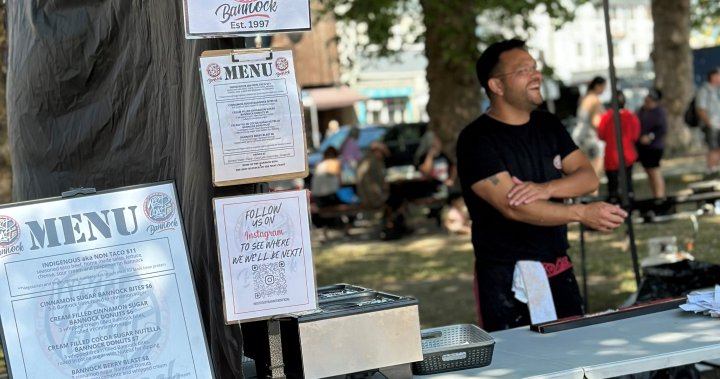
While powwows, bannock, frybread and Indian tacos go hand and hand, the Indigenous food staple is making its way off the powwow trail, helping bridge cultural divides and feeding the masses.
Richard Mark has been making bannock since he was a kid. He started “hustling” with his mom to make a little extra cash and the doughy staple got them through some hard times.
“There’s always been bannock around. When I moved to East Van in ’97 there was a West Coast night down at the friendship centre, and my mom started making bannock and going down there and selling it and I started helping out,” said Mark. “It was a good learning experience to be able to do that with my mom.”
“We (would) make stuff for the West Coast night and then we would literally bring a batch of bannock, walk around our building knocking door to door to see if anyone wanted to buy them before we got to West Coast night.”
Now, Mark has made bannock-making into a full-time business with West Coast Bannock.
West Coast Bannock is serving up Indigenous eats at powwows and beyond.
West Coast Bannock
While a modern Indigenous staple, bannock’s relevance across Indigenous communities originally had a lot to do with survival.
Flour, brought over during colonization, led to bannock’s inclusion in the country’s cuisine. Eventually the Canadian government would ration foods to Indigenous communities like flour and lard, making bannock a necessity to prevent starvation.
But Indigenous people adopted the food, made it their own and it can now be seen as an example of culinary resilience.
Just about every Indigenous community across Canada has its own version — bannock is dense and filling when baked, soft and fluffy when fried.

On National Indigenous People’s Day West Coast Bannock hosted a pop-up + fundraiser in collaboration with The Burrow.
West Coast Bannock / Instagram
The Nisga’a-Gitxsan chef said it’s up to people like him to get creative. “You can put anything on bannock,” he said.
“It’s just a staple at each powwow but I would really like to start introducing some new things to put on bannock and feed the people,” said Mark.
West Coast bannock is regularly changing up their menus for every event. At the Father’s Day Powwow they had Indian tacos, bannock bites with strawberries and Nutella; at the Kanata Day event they had bannock burgers and cinnamon sugar bannock bites.
Mark wants bannock to be a culinary staple, which is why he’s catering and selling at events like Surrey Fusion Fest, Caribbean Days Festival and Chinatown Festival.
“Everyone should know what bannock is,” said Mark.

And food — like bannock — can provide an opportunity for culture-sharing.
“Beyond merely nourishing the body, what we eat and with whom we eat can inspire and strengthen the bonds between individuals, communities, and even countries,” writes sociologist Vatika Sibal.
“Food functions symbolically as a communicative practice by which we create, manage and share meanings with others. Understanding culture, habits, rituals and tradition can be explored through food and the way others perceive it.”
And Mark knows that. He hopes to have a spot downtown someday so when tourists hop off cruise ships, one of the first things they see is an invitation to enjoy Indigenous cuisine.
“This is frybread, this is bannock, and if you wanna try it, come on down,” said Mark.
© 2023 Global News, a division of Corus Entertainment Inc.
















